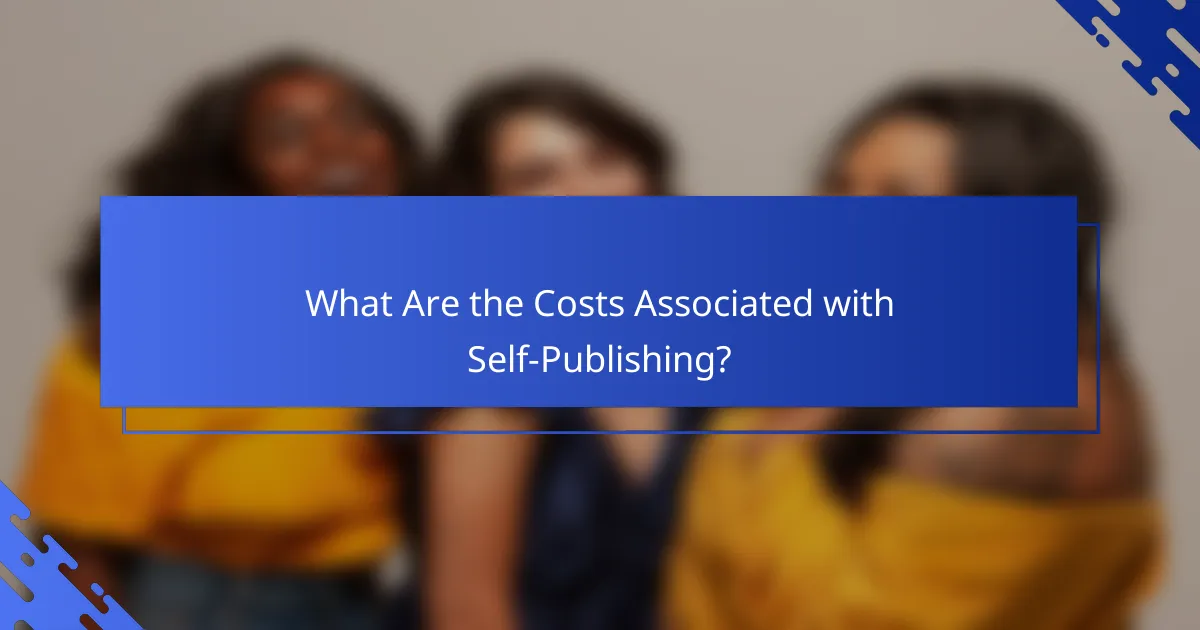For first-time authors, selecting the right self-publishing platform is crucial to successfully bringing their work to market. Options like Amazon Kindle Direct Publishing, IngramSpark, and Lulu each offer distinct features tailored to various needs. By considering factors such as distribution, royalty rates, and user experience, authors can find the ideal platform to launch their literary careers.

What Are the Best Self-Publishing Platforms for First-Time Authors?
First-time authors have several excellent self-publishing platforms to choose from, each offering unique features and benefits. The best options include Amazon Kindle Direct Publishing, IngramSpark, Smashwords, Draft2Digital, and Lulu, which cater to different needs and preferences.
Amazon Kindle Direct Publishing
Amazon Kindle Direct Publishing (KDP) is one of the most popular platforms for self-publishing eBooks and paperbacks. It allows authors to publish their work quickly and reach a vast audience through Amazon’s marketplace.
KDP offers a royalty rate of up to 70% for eBooks priced between $2.99 and $9.99, making it financially attractive. Authors can easily manage their titles, track sales, and make updates to their books whenever necessary.
IngramSpark
IngramSpark is a robust platform that provides authors with access to a global distribution network. It is particularly beneficial for those looking to publish print books and have them available in bookstores and libraries.
While IngramSpark charges a setup fee, it offers extensive distribution options and the ability to print on demand. Authors should consider the initial costs against the potential reach and visibility in the market.
Smashwords
Smashwords is an eBook publishing platform that focuses on distributing to multiple retailers, including Apple Books, Barnes & Noble, and Kobo. It is ideal for authors seeking to maximize their eBook’s availability across various platforms.
Smashwords offers a straightforward publishing process and provides authors with a 60-80% royalty rate, depending on the retailer. However, formatting requirements can be stringent, so authors should prepare their manuscripts accordingly.
Draft2Digital
Draft2Digital is another user-friendly platform that simplifies the eBook publishing process. It allows authors to publish their work and distribute it to several major retailers without the hassle of individual submissions.
With Draft2Digital, authors benefit from free formatting tools and a royalty rate of around 60-70%. It’s a great option for those who want a hands-off approach to distribution while still maintaining control over their work.
Lulu
Lulu is a versatile self-publishing platform that caters to both eBooks and print books, including photo books and calendars. It is known for its customization options, allowing authors to create unique formats and designs.
While Lulu charges for printing and distribution, it provides authors with a wide range of print options and global distribution channels. This platform is suitable for those who prioritize creative control and quality in their published works.

How Do I Choose a Self-Publishing Platform?
Choosing a self-publishing platform involves evaluating several key factors that can impact your book’s success. Focus on distribution options, royalty rates, and user-friendliness to find the best fit for your needs as a first-time author.
Evaluate distribution options
Distribution options determine where and how your book will be sold. Some platforms offer wide distribution to major retailers like Amazon, Barnes & Noble, and Apple Books, while others may focus on niche markets or specific regions.
Consider whether you want your book available in print, eBook, or both formats. Platforms like IngramSpark provide extensive print distribution, while Kindle Direct Publishing (KDP) is excellent for eBooks. Research each platform’s reach to ensure it aligns with your target audience.
Consider royalty rates
Royalty rates vary significantly among self-publishing platforms, impacting your earnings per sale. Most platforms offer royalties ranging from 35% to 70% for eBooks, depending on pricing and distribution choices.
For print books, royalties are typically lower, often around 40% to 60%. Be sure to read the fine print, as some platforms may have additional fees that affect your overall earnings. Calculate potential earnings based on your book’s price to make an informed decision.
Assess user-friendliness
User-friendliness is crucial for first-time authors who may not be tech-savvy. Look for platforms that provide intuitive interfaces, clear instructions, and responsive customer support to help you navigate the publishing process.
Platforms like KDP and Draft2Digital are known for their ease of use, offering step-by-step guides and helpful resources. Avoid platforms with complex setups or poor customer service, as these can lead to frustration and delays in your publishing journey.

What Are the Costs Associated with Self-Publishing?
The costs of self-publishing can vary widely, depending on the services you choose and the quality you aim for. Key expenses typically include platform fees, editing and design costs, and marketing expenses, all of which can significantly impact your overall budget.
Platform fees
Self-publishing platforms often charge fees for their services, which can include a percentage of sales or upfront costs. For example, platforms like Amazon Kindle Direct Publishing (KDP) take a commission of around 30-65% on royalties, while others may charge a flat fee for publishing.
When selecting a platform, consider both the fee structure and the services offered. Some platforms provide additional features like distribution to multiple retailers, which may justify higher fees if it leads to greater sales potential.
Editing and design costs
Editing and design are crucial for producing a professional-quality book. Hiring a professional editor can cost anywhere from a few hundred to several thousand dollars, depending on the level of editing required. Cover design can also range from $100 to over $1,000, depending on the designer’s experience and the complexity of the design.
To manage these costs, consider seeking out freelance editors and designers who offer competitive rates. Alternatively, some self-publishing platforms provide bundled services that can save you money while ensuring quality.
Marketing expenses
Marketing is essential for reaching your audience and driving sales. Costs can vary widely, from free social media promotions to paid advertising campaigns that may range from a few dollars to several thousand. Setting a budget for marketing is crucial, as it can significantly affect your book’s visibility.
Focus on cost-effective strategies like building an author website, utilizing social media, and engaging with readers through newsletters. Avoid overspending on untested advertising methods; instead, start small and scale up based on what works best for your book.

What Are the Key Features of Top Self-Publishing Platforms?
Top self-publishing platforms typically offer a range of essential features that cater to first-time authors. These include options for print and eBook formats, marketing tools to promote your work, and sales tracking to monitor performance.
Print and eBook options
Most self-publishing platforms provide both print and eBook formats, allowing authors to reach a wider audience. Print-on-demand services enable you to publish physical copies without upfront costs, while eBook formats like EPUB and MOBI ensure compatibility with various devices.
When choosing a platform, consider the quality of print options, such as paper type and binding. Look for services that offer customizable cover designs and formatting assistance to enhance the visual appeal of your book.
Marketing tools
Effective marketing tools are crucial for promoting your self-published book. Many platforms offer features like social media integration, email marketing options, and promotional pricing strategies to help you reach potential readers.
Some platforms also provide access to advertising services, such as Amazon Ads or Facebook Ads, which can significantly boost visibility. Consider platforms that offer analytics to track the success of your marketing efforts and adjust your strategies accordingly.
Sales tracking
Sales tracking is an essential feature that allows authors to monitor their book’s performance over time. Most self-publishing platforms provide dashboards that display sales data, including units sold and revenue generated, often broken down by format and region.
Look for platforms that offer real-time reporting and detailed insights, which can help you make informed decisions about future marketing efforts or pricing strategies. Understanding your sales trends can guide you in optimizing your promotional activities and maximizing profits.

What Are the Common Challenges for First-Time Self-Publishers?
First-time self-publishers often face several challenges, including understanding copyright issues, marketing their work effectively, and managing production timelines. Navigating these areas can significantly impact the success of their publishing efforts.
Understanding copyright issues
Copyright is crucial for protecting your intellectual property as a self-publisher. First-time authors should familiarize themselves with copyright laws in their country, which typically grant exclusive rights to the creator of the work upon its creation.
Registering your copyright can provide additional legal protection, especially if you plan to distribute your work widely. In the U.S., for example, registration is not mandatory but can be beneficial in case of infringement disputes.
Marketing effectively
Effective marketing is essential for reaching your target audience and driving sales. First-time authors should consider building an online presence through social media, author websites, and email newsletters to engage potential readers.
Utilizing platforms like Amazon KDP or Goodreads can help in promoting your book. Additionally, consider running promotional campaigns or offering free samples to attract interest and generate reviews.
Managing production timelines
Managing production timelines is vital to ensure your book is published on schedule. First-time authors should create a detailed timeline that includes writing, editing, formatting, and marketing phases to keep the project on track.
It’s advisable to allocate buffer time for unexpected delays, such as revisions or technical issues. A common approach is to set deadlines for each stage, allowing at least a few weeks for final edits and formatting before the release date.
